If you click on a link and make a purchase we may receive a small commission. Read our editorial policy.
A magical partnership: Evan Narcisse & Charles Stewart III talk Static Team-Up: Anansi
In an interview with Popverse, Evan Narcisse and Charles Stewart III talk reimagining a superhero team-up from Static Shock for comics for the first time

It’s been nearly three years since the Milestone Media relaunch provided a fresh iteration of the Dakotaverse, a superhero universe featuring fan-favorite characters like Static and Hardware. Now, Evan Narcisse and Charles Stewart III are taking the reins on Static Team-Up: Anansi #1 this June, bringing in the mystical African hero Anansi to comic books for the first time after he previously teamed up with Virgil Hawkins on the Static Shock animated series.
Set before the events of Static’s current monthly comic book series Static: Shadows of Dakota, Anansi comes to Dakota where he meets Static, plunging Virgil into the middle of an occult adventure.
Static Team-Up: Anansi offers a showcase for what exactly this relaunched incarnation of the Dakotaverse is capable of, retaining and updating qualities of the classic shared universe while incorporating elements from Milestone’s wider multimedia franchise. The characters appearing in the title are still immediately recognizable as Static and Anansi, but the relaunch not only presents the opportunity for a first meeting but also brings more supernatural overtones to the Dakotaverse. And with Stewart a part of the 2022 Milestone Initiative, a DC-backed talent development program, a new generation of creators continues to make in-roads while shaping the landscape of the new Dakotaverse.
In an exclusive interview with Popverse, Evan Narcisse and Charles Stewart III reflect on their own personal connections to Milestone and tease what fans can expect from this team-up between Static and Anansi as the Dakotaverse learns more into the paranormal. We also have exclusive unlettered preview pages of the special below.

Popverse: Evan and Charles, what were your own gateways into Milestone?
Evan Narcisse: 2.27.93. If you weren’t there, you won’t get it. I was there day one for Milestone. It’s been fun to watch the younger fans come to Static from the animated series and see the resurgence of the character, but I was there from the beginning. I’ve been a fan of Dwayne McDuffie and Denys Cowan’s since their pre-Milestone days. When Dwayne was doing Damage Control at Marvel, I was there. Denys’ history goes back to when he was a teenager, and I remember him doing covers for Marvel and then his DC work. The Question is burned in my brain as one of the best things I think he’s ever done, with Dennis O’Neil writing.
I was just watching them from the earliest days of my comic book-reading fandom. Back in the day, you didn’t know who was Black. It wasn’t until I saw a caricature of Dwayne in Marvel Age when he was an assistant or associate editor at Marvel at the time. There was a little caricature that ran with a bio profile of him, and it was like 'Oh, there’s a Black guy!' Once I knew that, I paid special attention. In my teenage years I started to pay attention to the credits in comics, for who wrote, drew, and edited. It was harder to find out who was working on what back then but, if I knew Dwayne was working on something, I definitely checked it out.
One of my sources for news about the comic book industry was The Comic Buyer’s Guide, it was a magazine printed on newsprint, and I would get that. The announcement of Milestone, they were the first place to run it. They ran character sketches of Hardware, Icon, Static, and maybe some Blood Syndicate characters. One thing I’ll never forget from that era was that Icon’s original name was “Paragon,” but they had to change it because of a conflict with something.
Once I knew Milestone was a thing, that these Black creators were coming together to create their own thing, I was all over it. When Hardware #1 came out, I was like “Yes, give me more!” It was two of my favorite creators telling a story that touches on their lived experiences and some commonalities with my lived experiences, so I was just on-board.
When Static came out, it was just stunning to me how they captured how it felt like to be a Black teenager in that moment. Neither Dwayne nor Robert Washington III were teenagers when they were writing it but, I think one of the things that’s tricky to do when you’re writing teenage characters in fiction, especially superhero comics, is not feel behind the times, corny, or the ethos of that “Hello, fellow kids” meme. You’re meeting their audience where they are and, at this point, I was in college so I was a little older than Virgil was in the comics.
He’s talking about playing Mortal Kombat with his friends and his dad, “Nobody jams Raiden like I jam Raiden.” That was one of his lines from the comic’s first year or so when he’s playing with his dad and, [for me], it was the same thing. Me and my friends bullshit and skip class to play Mortal Kombat all the time. It just felt like they were really channeling the energy of the moment into comics in a way that I had never seen before. It was amazing.
Charles Stewart III: Like many of my peers, my introduction to the Milestone Universe was through Static himself, or specifically, the Static Shock animated TV series. The story and script that Evan had constructed were great, and I wanted to capture that in how I represented Virgil alongside Anansi. Although Virgil is a kid and shows respect to older folks and figures of authority, he’s still his own character and has his own journey that he gets to walk instead of being relegated as a subservient character. I made an effort to represent that visually in the story.

With Static Team-Up, you’re bringing in Anansi, who was played by Carl Lumbly in Static Shock. What was it about having Anansi come to Dakota for this story?
Narcisse: To stay on the early days of Milestone for a hot minute, in that Comic Buyer’s Guide article, there was also a character sketch for M.A.N.T.I.S., which was a science fiction TV show where Carl Lumbly played the main character. He’s a guy who is paralyzed but wore an exoskeleton that let him walk and gave him super strength and speed. Denys Cowan did the design for that suit, and the show was created by Sam Raimi and Sam Hamm. Sam Hamm was the screenwriter for the first Michael Keaton Batman movie and also wrote the 50th anniversary special for Batman that Denys Cowan actually drew so there are some commonalities there, and apparently they all knew each other.
The thing about the Static Shock TV show is that I was too old to watch it. By the time that it aired in 2000, I was already in my 20s, but I knew it was Static and I had to watch it. When the Anansi episodes started, with that first one, you hear that voice and I was like “That’s the dude from M.A.N.T.I.S.! That’s Carl Lumbly!” I knew him from some other stuff too, I had seen him on Broadway in some August Wilson plays.
This was a man with gravitas who could go from theater to science fiction TV, and now he was in animated superhero stuff. The things you love about Carl Lumbly are there in the Anansi character. He’s sly, slightly mischievous, avuncular, and warm. Most fans probably know him from playing Martian Manhunter on Justice League. He’s Black nerd royalty; he went on to play Isaiah Bradley on The Falcon and the Winter Soldier.
My experience with Anansi is really foundational because, way before I saw the character on the animated series, I had been familiar with him from West African folk tales that I read as a teenager and a college student. African folklore has always fascinated me, I’ve always been a big mythology buff, and the folk stories and mythology from West Africa are not as widely known as their Greco-Roman counterparts. I was like 'Oh, word? They’re doing this?'
I thought it was interesting how they did it because he was a trickster, which was explicit in the way he manifested his powers and moved through the world in those episodes. The show made a very explicit point of uplifting the African folklore traditions that Anansi comes from. They elevated the ancient Ashanti culture and kingdoms, and we were getting all of this from a Saturday morning TV show; it was freaking amazing.
A couple years ago I was at a friend’s place watching old episodes of Static Shock. and this episode came on and I was like, 'They really did a lot more than they had to here!' So getting the call for this project was really humbling. Everything I’ve been fortunate enough to do, with regard to the Milestone characters, I’m always conscious of continuing the legacy of some of the best people who ever did it.
Dwayne McDuffie is an all-star and the same thing with Denys Cowan, and, talking about the people who are not with us anymore, like John Paul Leon and Robert Washington-- they’re great creators. That was daunting, but there is so much opportunity with how this version of Anansi could build off the version that was on the animated series. I’m trying to keep some of the same character tonalities but also expanding the possibility of what he can do and what he can symbolize.
Stewart: To be honest, the original design was pretty sharp in its inception. The only thing that I wanted to add was to give a little more nuance into the African aesthetic, such as his belt and staff, even the spider symbol on his back. But I felt pretty confident about its original design, that I didn’t want to stray too far from it.
Speaking of the staff, I definitely wanted to make it more unique than just a slender piece of wood, something that actually looked hand-carved and had an African design to it. It’s similar to Jafar’s staff in Aladdin, I wanted it to stand out visually.
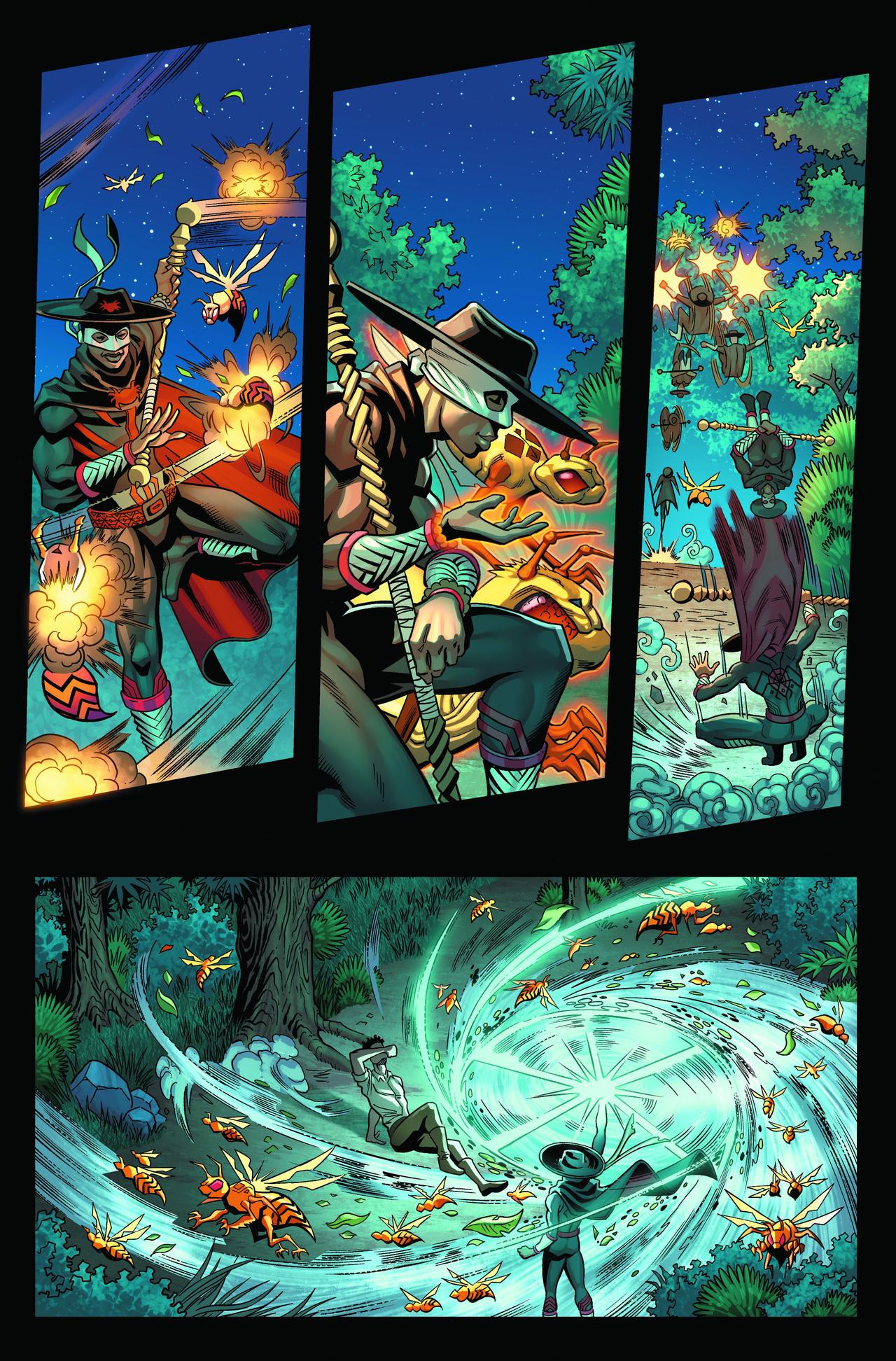
Whenever I hear “Anansi,” I think of what Greg Anderson Elysee is doing with Is’nana the Were-Spider. Anansi is one of the few heroes not explicitly tied to the Big Bang, so how did you want to juxtapose that difference with Static here?
Narcisse: There are a couple things. Yes, this version of Anansi is not explicitly linked to the Big Bang, and I thought that was important because we’re going to see some of the Big Bang’s consequences ripple out across the larger world in the Dakotaverse outside of the city of Dakota. As a fictional construct, in order for the Dakotaverse to feel really rich, you have to come at the idea of metahuman possibilities from different vectors. The thing with Anansi, it gives the opportunity to really explore the mystical, occult, and magical aspects of this fictional construct.
I lean hard on that, and [something] the editor on the project, Marquis Draper, said that helped me unlock it was “This is science meets magic.” I was already kind of going ther,e but playing up the air of mystery around Anasi felt like a way to expand the horizons of what this version of the Dakotaverse could be. In the original iteration of the Milestone Universe, there weren’t a lot of magic users. There was Demon Fox, Kwai, and of course Xombi. That wonderful book by John Rozum and J.J. Birch was almost exclusively about weird magic-type stuff and the series that Rozum did with Frazer Irving in the early 2000s was just so wonderful.
The Dakotaverse in the early ‘90s was mostly a science hero universe. It was mostly scientific, and I think that’s owed in large part because Dwayne McDuffie had a [graduate degree] in applied physics; he was an actual genius. That felt like the bedrock, and Static is a character who is a science nerd in the original iteration and this one. How does someone like him handle supernatural occurrences? That was part of what I wanted to hone in on.
The other part that happens in the project is that there are some old Milestone characters that are reinvented in some new ways, but I won’t say anything more for spoilers. It was fun to reapproach and reimagine parts of the old universe, parts of the animated Static Shock series, and fold them into the new version of the Dakotaverse. It was just so much fun.
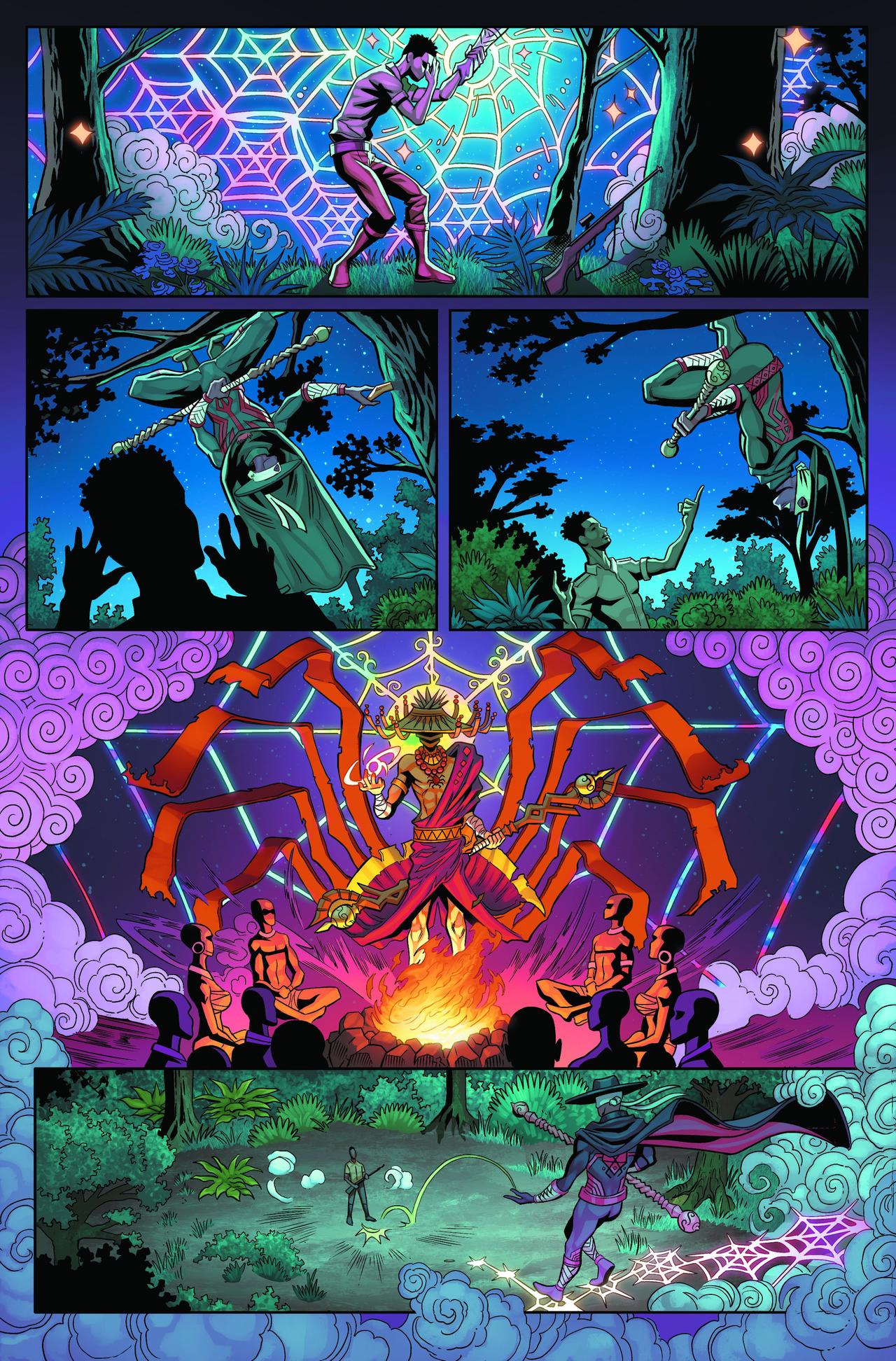
As you were saying, this is a new iteration of the Dakotaverse that’s been around for about three years now. What are some of the opportunities that you wanted to approach that maybe weren’t present in the original version?
Narcisse: I think one of the overriding changes in this version of the Dakotaverse is the fact that Black culture globally is more of a forge for innovation, discourse, and cultural impact than it was in the ‘90s. In the ‘90s, hip hop was still being talked about in the tones of moral panic, like 'It’s robbing our children of their innocence!' Now we live in a world where half the slang we use comes from hip hop.
Black culture and the attendant freedom struggles that have surrounded Black people for centuries are something that I think your average person has a little more knowledge about – hopefully a lot more knowledge about. I think that energy has multiplied since the ‘90s, and the current iteration of Milestone taps into that in a big way. I think the thing that the Milestone comics have done in both iterations is try to speak to the moment and really talk about the lived experiences of Black and marginalized communities as they’re happening.
I think there’s strength in the fact that these characters can be adapted to different times while also having this kernel that stays true to who they are from the original inception. Take a character like Masquerade, who was utterly groundbreaking in the ‘90s, a character who was gender fluid and could certainly be interpreted as trans. Now in 2023 when trans rights are something that are being so hotly debated in mainstream culture – I think probably the most important civil rights struggle of our times right now is surrounding trans people. Here, we get to explore that with Masquerade. I’m not touching that character, that’s all Geoff Thorne in Blood Syndicate, but still important. It just shows how forward-looking the original version of the Milestone Media Universe was. We need Milestone, the Dakotaverse, and those characters in a different way than we did in 1993. We need them now for different reasons, and the way we talk about identity, difference in lived experiences, and systemic oppression has changed.
These characters are still probably the best suited in superhero culture to tackle those issues. They’re different than the X-Men because there is no metaphor, we’re actually in it. People hate us because we are Black, Latinx, trans, or queer; it’s not about a metaphor, like the mutant gene. That’s not a shade to the X-Men franchise, but it’s a lot more pointed and direct. You get a different kind of engagement from the readers and creators by the virtue of that.
Evan, Charles, how was it working together on this?
Narcisse: Amazing! I always say that comics are alchemy because you can take the words of a writer, which are lead, and that’s not to say that they’re not valuable, but then an artist takes them and transmutes them into gold – shiny, reflective, and vibrant. It’s always interesting to see [how] an artist is going to interpret a script and Charles knocked it out of the park. There’s a scene set at a Juneteenth celebration in Dakota, and it’s one thing to write “big street fair,” and it’s another thing to see these things so full of life, pride – Black pride, to be perfectly frank, pride in our African heritage.
Charles really wanted to bring those elements to the forefront of the story, and it’s a story featuring an African superhero with Anansi, so it made perfect sense. That energy is amazing, his layouts are really fun and amazing. He creates this visual language for Anansi and his powers that I could not be happier with, it’s great.
The other thing about working with Charles is that I feel like the Milestone Initiative is the deepest fulfillment of the most important part Milestone’s legacy, which is developing talent and opening doors for people from different ethnic, cultural, and marginalized backgrounds. You look at the people who came on board because of Milestone – J.H. Williams III, John Paul Leon, Humberto Ramos, ChrisCross, and that’s just the artists! People like Ivan Velez, Robert Washington, Joe Illidge, they’re stars and some of best, sharpest talent of their generations have started at Milestone.
The fact that DC has institutionalized that type of talent development, which is incredibly freaking rare in comics. A lot of time in comics, you’re on your own and you’re lucky to know some professionals or have some peers that you can have some community with. Otherwise, it’s a very lonely pursuit for those resources.
These guys all ride with each other now – Morgan Hampton, Charles Stewart III, Jordan Clark, Cheryl Lynn Eaton, Atagun – they’re from all different walks of life. It’s like going to school together but also learning craft and then going out there and getting paying work amongst your peers. That feeling of camaraderie, I’m honestly jealous of. [laughs] I’ve got my own team of creators and we talk about craft but, to get to do that under the auspices of this kind of program is amazing.
Charles is an incredibly bright talent, and I definitely want to work with him again. His designs for certain characters, we’re getting a first look at some Bang Babies here. He was like, 'Do you have anything in mind?' and I was like 'Go wild!,' and he did. I think he’s a really good talent.
Stewart: I’ve worked on other projects with different writers and, for me, the biggest thing I appreciate in a collaboration is communication. And with Evan, the communication was as smooth as ice! Evan was really on top of answering my questions when I messaged him. I know everyone has different preferences for communication, but I’m very appreciative when I can just text someone a question, even with visual references, to get an idea of what needs to be done in the story.
Other writers I’ve worked with in the past sometimes weren’t able to communicate over the phone or had issues replying in a timely manner. So overall, I was very satisfied with being able to communicate back-and-forth via text or over the phone about ideas on how I could elevate the story on my end. I hope to work with him and other writers of his caliber in the future.
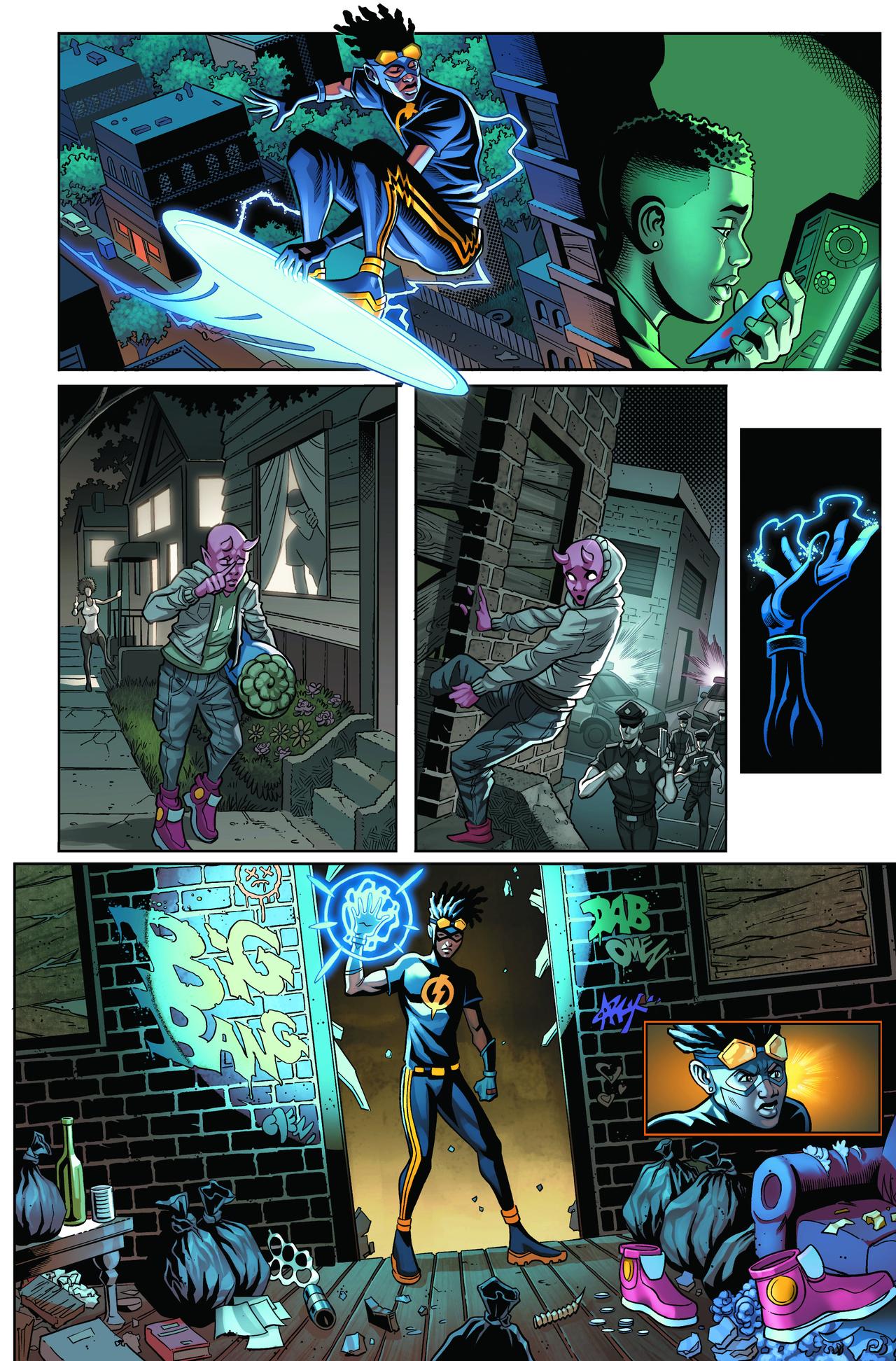
I was speaking with Joseph Illidge about that a couple months ago, that there was this invitational aspect to comics with the launch of Milestone and what Larry Stroman was doing with The Tribe at Image Comics, and then it felt like the portal reclosed around the late ‘90s.
Narcisse: Unfortunately, that is always the cyclical nature around Black creativity. It’s something that haunts me, like 'You may get a chance now, so make the most of it because you operate in a society that doesn’t always give Black creators as many chances as non-Black ones.' That’s what I’ll say about that.
Charles, what would you say is the biggest thing you learned from the Milestone Initiative?
Stewart: The Milestone Initiative was a great experience where I had the chance to learn from teachers, mentors, and my fellow cohorts as well. One of the greatest lessons I learned from that time was just to continue to grow. I know that answer feels anticlimactic and expected, but that’s it. Just continue to grow.
Continue to grow in your craft. Continue to grow in your creative innovation. Continue to grow in your technical knowledge of drawing or writing. Continue to grow in your contextual knowledge of the world and life experiences. Those things will help you influence how you write or draw. And lastly, continue to grow in your networking relationships in the industry.
Networking is important to make connections to get work, but it can also lead to building friendships and family bonds that can last for years. Because, at the end of the day, we’re all a bunch of comic nerds who love comic culture and making comics for other nerds to read, but with high level skill and professionalism. And, because of that, I will continue to grow.
What was it about the timeline placement for this team-up? This story takes place before Static: Shadows of Dakota, so what was it about this specific point in time that you wanted to explore?
Narcisse: The opportunity that I wanted to explore there was the idea that the Big Bang and the emergence of this new generation of metahumans in Dakota is an event of cosmic importance. Cosmic in the astronomical sense, with the universe as we know it and perceive it through our senses, and cosmic in the mystical sense. This version of Anansi is a storyteller and taps into the power of story, which was kind of hinted at in the animated version, but it’s much more explicit here.
The Big Bang and emergence of this new generation of metahumans is of cosmic importance, and he’s like 'I’ve been tracking this. Let me see what these people are all about.' There are events in the story that cause him and Virgil to crash into each other. The idea that this is really important globally and dimensionally is a big part of the story. Virgil finds himself having to reckon with that a little bit.
In terms of the timeline of the current Dakotaverse, we’re just getting a sense that the world is opening up and these horizons are expanding and are going to be dangerous and intriguing in ways that people hadn’t expected.
What else can you tease about Static Team-Up as we see these versions of these characters meet for the first time?
Narcisse: That sense of unexplored vistas is something that I wanted to seed into this story, to sprinkle some new possibilities of where this version of the Dakotaverse could be. Anansi starts off as a mystery in this story and maintains that mystery. That air of mystery is something, hopefully, that this iteration of the character gets to explore and expound on in future Milestone projects.
Static Team-Up: Anansi #1 is written by Evan Narcisse and illustrated by Charles Stewart III. The issue goes on sale June 6 from DC Comics.
Doctor Who: Is the big comeback story based on a comic book drawn by Watchmen's Dave Gibbons?
Follow Popverse for upcoming event coverage and news
Find out how we conduct our review by reading our review policy
Let Popverse be your tour guide through the wilderness of pop culture
Sign in and let us help you find your new favorite thing.



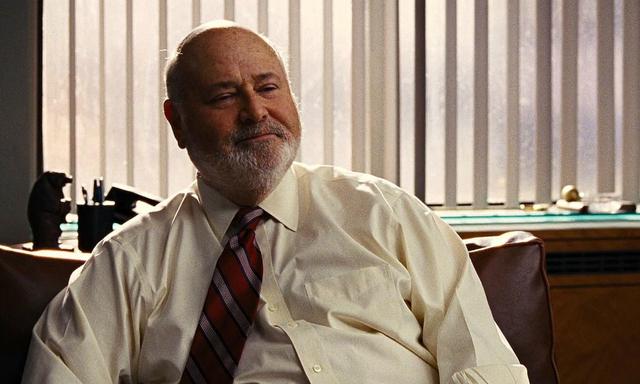
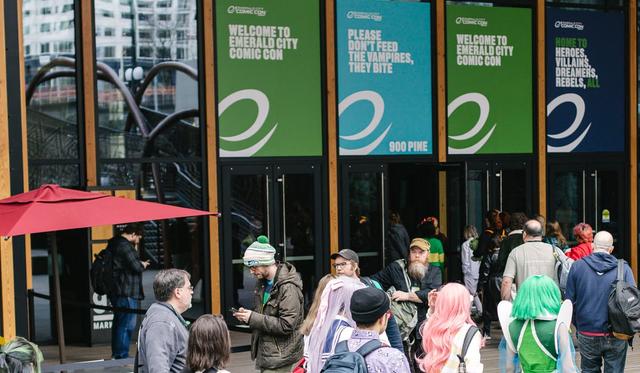



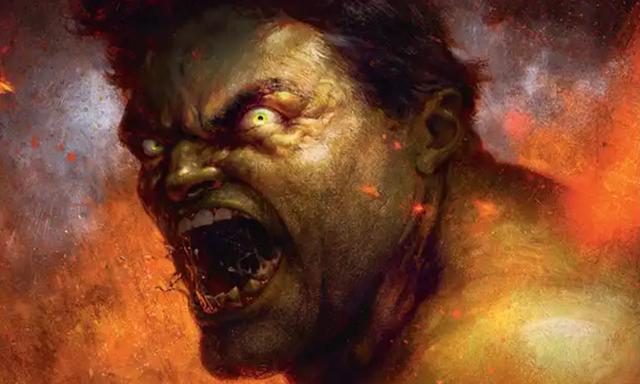
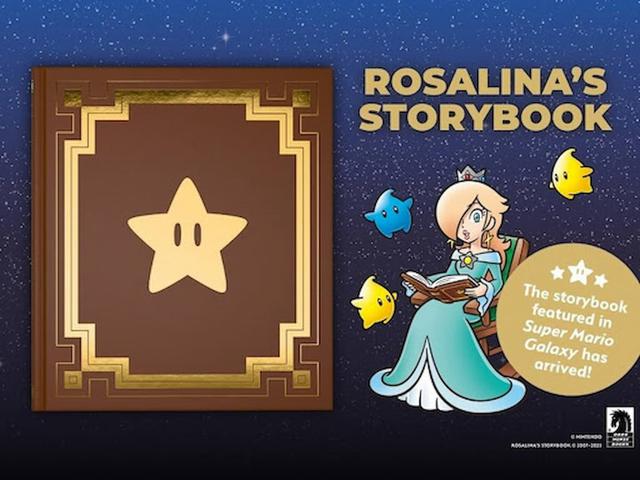






Comments
Want to join the discussion? Please activate your account first.
Visit Reedpop ID if you need to resend the confirmation email.